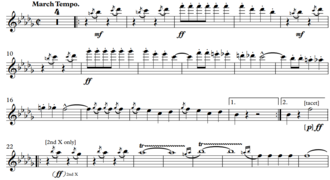Nobles Of The Mystic Shrine (march)
Background
John Philip Sousa was an American composer and conductor. He served as the director of the United States Marine Band from 1880 to 1892. During his tenure, he was popularly referred to as the "March King". In 1881, Sousa became a Freemason and on November 18 the same year, he was raised to a third-degree mason. After leaving the marine band, Sousa started his own band, which he later called "Sousa's Band". In April 1922, Sousa became a member of the Ancient Arabic Order of the Nobles of the Mystic Shrine (AAONMS). He was soon named their first honorary director.
Composition and analysis
On the request of his nephew, A. R. Varela, Sousa composed a march titled "Nobles of the Mystic Shrine". According to author Paul E. Bierley, "The new march saluted Shriners", but was specifically dedicated to the Almas Temple and the AAONMS.
"Nobles of the Mystic Shrine" is one of the few of Sousa's marches in which the introduction and the first strain is written in the minor mode. The march is approximately 3 minutes 30 seconds long. The introduction begins in a minor key, which drops to mezzo-forte during the first strain. According to the Marine Band, Sousa added triangles to the first strain to "reinforce the mystical theme of the march". Piccolo, E♭ Clarinet, cornets, trumpets, trombones, and cymbals are tacet during most of the second strain. The trio has been referred by the Marine Band as one of Sousa's "most elegant trio melodies". Bells are first played during the trio. In the break strain, all the instruments are played back with a subito fortissimo (sff). A diminuendo is also added to the percussion instruments. In the final strain, all the instruments are played with a sff. A Jingling Johnny bell tower is also added, which is played, according to the Marine Band, to "bring home the exotic character" of the march.

The structure of the march is:
- Introduction: F major
- First strain: B-flat minor
- Second strain: D-flat major
- Trio: G-flat major
- Break strain: B-flat minor
- Final strain: G-flat major
Instrumentation
English composer Philip Sparke made few changes to the march, and the instrumentation of his version included:
- Woodwind
- 1 piccolo
- 1 flute
- 1 oboe
- 1 E-flat clarinet
- 3 clarinets
- 1 bass clarinet
- 1 bassoon
- 1 alto saxophone
- 1 tenor saxophone
- 1 baritone saxophone
Performance
The march was first conducted during the Shriners' National Convention in Washington, D.C., in June 1923. At the Griffith Stadium, Sousa conducted a band of around 6,200 members—the largest he had ever conducted. Sousa was wearing a navy-blue uniform and a red Almas Shrine fez. He conducted the march twice before conducting "The Thunderer". Various Shriners accompanied Sousa during his tours, and during the later years of Sousa's band, the majority of his members were Shriners. Contemporary versions of the march by the Ottoman military band also use the Jingling Johnny with the fortissimo.
References
- ^ Allsen, J. Michael (2000) [1999]. "Sousa, John Philip". American National Biography. Oxford University Press. doi:10.1093/anb/9780198606697.article.1801080. ISBN 978-0-19-860669-7. Archived from the original on November 6, 2020. Retrieved January 14, 2022.
- ^ White, John (2009). "Sousa's March of Greatness". The New American. Vol. 25, no. 18. ISSN 0885-6540.
- ^ Ladd, Adam Richard (2014). "An Examination of Works for Wind Band and Brass Ensemble: Toccata for a Band by Frank Erickson, Mutations from Bach by Samuel Barber, and Nobles of the Mystic Shrine by John Philip Sousa" (PDF). Kansas State University. Archived from the original (PDF) on January 13, 2022. Retrieved January 14, 2021.
- ^ Bierley, Paul E. (2006). The Incredible Band of John Philip Sousa. University of Illinois Press. ISBN 978-0-252-03147-2. LCCN 2006011277. OL 9859624M. Retrieved January 14, 2021.
- ^ "'Nobles of the Mystic Shrine' (1923)". United States Marine Band. Archived from the original on June 11, 2021. Retrieved January 14, 2022.
- ^ Bierley, Paul E (1984). The Works of John Philip Sousa. Integrity Press. ISBN 978-0-918048-04-2. LCCN 84080665. OL 2876313M. Retrieved January 14, 2021.
- ^ "Nobles of the Mystic Shrine (score)" (PDF). United States Marine Band. 2020. Retrieved January 14, 2021.
- ^ Cosenza, Frank (2020). "Nobles of the Mystic Shrine". Circus Fanfare. Vol. 50, no. 5. ISSN 1056-1463.
- ^ Dugan, Patrick W. (2018). "The Nobles of the Mystic Shrine Bands". School Band & Orchestra. Vol. 21, no. 9. ProQuest 2125591042.
External links
- Official music score — via United States Marine band
- Nobles of the Mystic Shrine: Scores at the International Music Score Library Project
 Media related to Nobles of the Mystic Shrine at Wikimedia Commons
Media related to Nobles of the Mystic Shrine at Wikimedia Commons